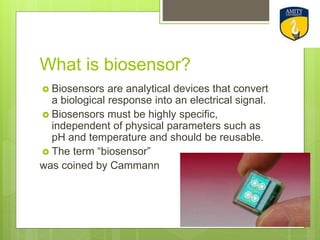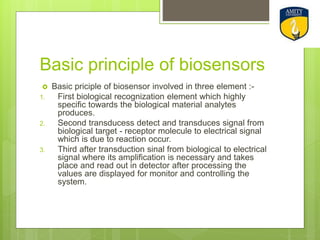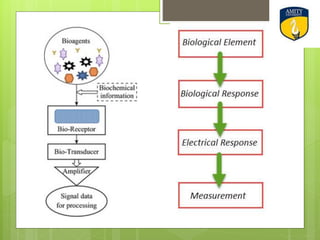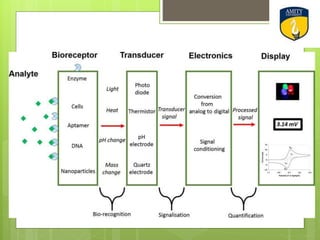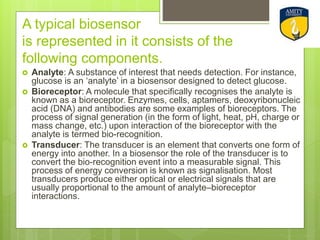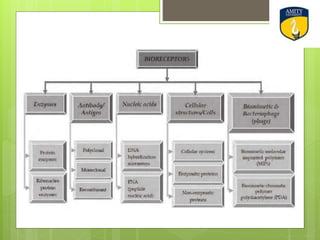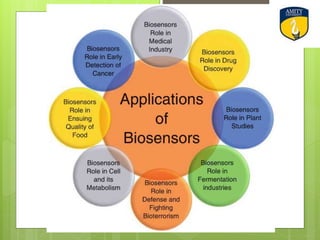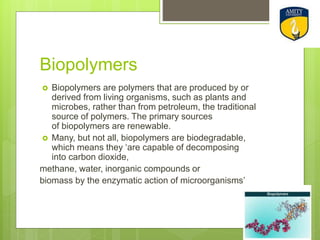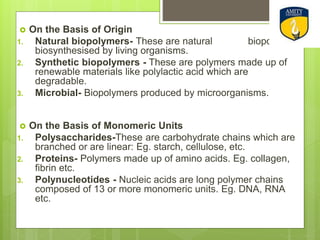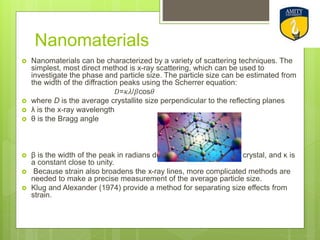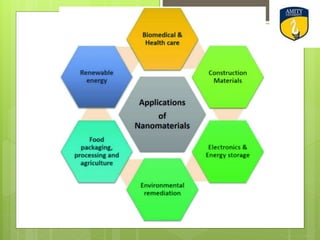History of the biosensors and applications
- 2. History of biosensors M. Cremer established that the concentration of an acid in a liquid is proportional to the electric potential that occurs between segments of the fluid positioned on opposite sides of a glass membrane. Yellow spring instruments eventually created the first commercial biosensor in 1975. The first immunosensor, ovalbumin or egg protein on a platinum wire, and the microbe biosensor paved the way for modern detection in 1975 In the realm of biosensors, considerable progress has been made since the development of the i-STAT sensor.
- 3. What is biosensor? Biosensors are analytical devices that convert a biological response into an electrical signal. Biosensors must be highly specific, independent of physical parameters such as pH and temperature and should be reusable. The term “biosensor” was coined by Cammann
- 4. Fabrication of biosensors, its materials, transducing devices, and immobilization methods requires multidisciplinary research in chemistry, biology, and engineering. The materials used in biosensors are categorized into three groups based on their mechanisms: 1. bio catalytic group comprising enzymes 2. bio affinity group including antibodies and nucleic acids 3. microbe based containing microorganisms.
- 5. Basic principle of biosensors Basic priciple of biosensor involved in three element :- 1. First biological recognization element which highly specific towards the biological material analytes produces. 2. Second transducess detect and transduces signal from biological target - receptor molecule to electrical signal which is due to reaction occur. 3. Third after transduction sinal from biological to electrical signal where its amplification is necessary and takes place and read out in detector after processing the values are displayed for monitor and controlling the system.
- 8. A typical biosensor is represented in it consists of the following components. Analyte: A substance of interest that needs detection. For instance, glucose is an ‘analyte’ in a biosensor designed to detect glucose. Bioreceptor: A molecule that specifically recognises the analyte is known as a bioreceptor. Enzymes, cells, aptamers, deoxyribonucleic acid (DNA) and antibodies are some examples of bioreceptors. The process of signal generation (in the form of light, heat, pH, charge or mass change, etc.) upon interaction of the bioreceptor with the analyte is termed bio-recognition. Transducer: The transducer is an element that converts one form of energy into another. In a biosensor the role of the transducer is to convert the bio-recognition event into a measurable signal. This process of energy conversion is known as signalisation. Most transducers produce either optical or electrical signals that are usually proportional to the amount of analyte–bioreceptor interactions.
- 9. Electronics: This is the part of a biosensor that processes the transduced signal and prepares it for display. It consists of complex electronic circuitry that performs signal conditioning such as amplification and conversion of signals from analogue into the digital form. The processed signals are then quantified by the display unit of the biosensor. Display: The display consists of a user interpretation system such as the liquid crystal display of a computer or a direct printer that generates numbers or curves understandable by the user. This part often consists of a combination of hardware and software that generates results of the biosensor in a user-friendly manner. The output signal on the display can be numeric, graphic, tabular or an image, depending on the requirements of the end user.
- 14. Biopolymers Biopolymers are polymers that are produced by or derived from living organisms, such as plants and microbes, rather than from petroleum, the traditional source of polymers. The primary sources of biopolymers are renewable. Many, but not all, biopolymers are biodegradable, which means they ‘are capable of decomposing into carbon dioxide, methane, water, inorganic compounds or biomass by the enzymatic action of microorganisms’
- 15. Classes of biopolymers There are three main classes of biopolymers, classified according to the monomers used and the structure of the biopolymer formed: polynucleotides, polypeptides, and polysaccharides. The Polynucleotides, RNA and DNA, are long polymers of nucleotides. Polypeptides include proteins and shorter polymers of amino acids; some major examples include collagen, actin, and fibrin. Polysaccharides are linear or branched chains of sugar carbohydrates; examples include starch, cellulose, and alginate. Other examples of biopolymers include natural rubbers (polymers of isoprene), suberin and lignin (complex polyphenolic polymers), cutin and cutan (complex polymers of long-chain fatty acids), melanin, and polyhydroxyalkanoates (PHAs).
- 17. Types of biopolymers Biopolymers can be classified according to various scales. These classifications are based on their origin, a number of monomeric units, on the basis of degradability, their heat response etc. Some of the classifications are: On the Basis of Type 1. Sugar-based polymers- Starch or sucrose is used as input for manufacturing. Lactic acid polymers are created using lactose from potatoes, maise, etc. 2. Starch-based polymers- Starch acts as a natural polymer, composed of glucose. It is found in plant tissues. 3. Cellulose-based biopolymers- Used for packaging, this polymer is made up of glucose obtained from natural sources like cotton. Eg. cellophane. 4. Synthetic materials- Degradable polymers can be made from synthetic materials obtained from petroleum.
- 18. On the Basis of Origin 1. Natural biopolymers- These are natural biopolymers biosynthesised by living organisms. 2. Synthetic biopolymers - These are polymers made up of renewable materials like polylactic acid which are degradable. 3. Microbial- Biopolymers produced by microorganisms. On the Basis of Monomeric Units 1. Polysaccharides-These are carbohydrate chains which are branched or are linear: Eg. starch, cellulose, etc. 2. Proteins- Polymers made up of amino acids. Eg. collagen, fibrin etc. 3. Polynucleotides - Nucleic acids are long polymer chains composed of 13 or more monomeric units. Eg. DNA, RNA etc.
- 20. Nanomaterials Nanomaterials can be characterized by a variety of scattering techniques. The simplest, most direct method is x-ray scattering, which can be used to investigate the phase and particle size. The particle size can be estimated from the width of the diffraction peaks using the Scherrer equation: 𝐷=𝜅𝜆/𝛽cos𝜃 where D is the average crystallite size perpendicular to the reflecting planes λ is the x-ray wavelength θ is the Bragg angle β is the width of the peak in radians due to the finite size of the crystal, and κ is a constant close to unity. Because strain also broadens the x-ray lines, more complicated methods are needed to make a precise measurement of the average particle size. Klug and Alexander (1974) provide a method for separating size effects from strain.
- 21. Nano-sized particles exist in nature and can be created from a variety of products, such as carbon or minerals like silver, but nanomaterials by definition must have at least one dimension that is less than approximately 100 nanometers. Most nanoscale materials are too small to be seen with the naked eye and even with conventional lab microscopes. Materials engineered to such a small scale are often referred to as engineered nanomaterials (ENMs), which can take on unique optical, magnetic, electrical, and other properties. These emergent properties have the potential for great impacts in electronics, medicine, and other fields. For example, 1. Nanotechnology can be used to design pharmaceuticals that can target specific organs or cells in the body such as cancer cells, and enhance the effectiveness of therapy. 2. Nanomaterials can also be added to cement, cloth and other materials to make them stronger and yet lighter. 3. Their size makes them extremely useful in electronics, and they can also be used in environmental remediation or clean-up to bind with and neutralize toxins.
- 23. Where are nanomaterials found? Some nanomaterials can occur naturally, such as blood borne proteins essential for life and lipids found in the blood and body fat. Scientists, however, are particularly interested in engineered nanomaterials (ENMs), which are designed for use in many commercial materials, devices and structures. already, thousands of common products-- including sunscreens, cosmetics, sporting goods, stain-resistant clothing, tires, and electronics—are manufactured using ENMs. They are also in medical diagnosis, imaging and drug delivery and in environmental remediation.
- 24. Types of nanomaterials Nanomaterials can be categorized into four types such as: 1. inorganic-based nanomaterials 2. carbon-based nanomaterials 3. organic-based nanomaterials 4. composite-based nanomaterials. Generally, inorganic-based nanomaterials include different metal and metal oxide nanomaterials. Examples of metal-based inorganic nanomaterials are silver (Ag), gold (Au), aluminum (Al), cadmium (Cd), copper (Cu), iron (Fe), zinc (Zn), and lead (Pb) nanomaterials, whereas examples of metal oxide-based inorganic nanomaterials are zinc oxide (ZnO), copper oxide (CuO), magnesium aluminum oxide (MgAl2O4), titanium dioxide (TiO2), cerium oxide (CeO2), iron oxide (Fe2O3), silica (SiO2), and iron oxide (Fe3O4), etc.
- 25. Carbon-based nanomaterials include graphene, fullerene, single-walled carbon nanotube, multiwalled carbon nanotube, carbon fiber, an activated carbon, and carbon black. The organic-based nanomaterials are formed from organic materials excluding carbon materials, for instance, dendrimers, cyclodextrin, liposome, and micelle. The composite nanomaterials are any combination of metal-based, metal oxide-based, carbon-based, and/or organic-based nanomaterials, and these nanomaterials have complicated structures like a metal-organic framework.


